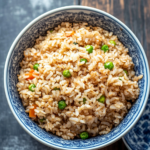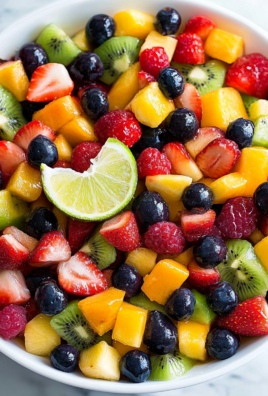Fried rice is a versatile and flavorful dish that originated in China but has been adapted into many Asian cuisines, including Japanese hibachi-style fried rice. This dish is known for its buttery, umami-rich taste and the perfect balance of textures—soft grains of rice with a slight crispness from stir-frying.
Homemade fried rice is not only quick and easy but also customizable. You can use leftover rice, mix in your favorite vegetables, and even add protein like chicken, shrimp, or tofu. This recipe delivers restaurant-quality fried rice in just 30 minutes, making it a perfect side dish or a complete meal.

Essential Tools and Ingredients
Tools You Need
- Wok or large skillet – Distributes heat evenly for proper frying.
- Spatula or wooden spoon – Helps toss and stir ingredients effectively.
- Small bowls – Keeps prepped ingredients organized for a smooth cooking process.
Key Ingredients
- Rice – Cold, day-old rice is best. Short-grain, long-grain, or jasmine rice all work.
- Egg – Adds protein and texture.
- Vegetables – Peas, carrots, and onions provide color and sweetness.
- Butter – Gives the signature hibachi-style richness.
- Soy sauce – The base seasoning that enhances umami.
- Cooking oil – Peanut, canola, or vegetable oil for frying.
- Sesame oil (optional) – Adds extra depth and aroma.
Preparation Steps
Step 1: Prepare the Rice
- Cook the rice according to package instructions.
- Spread it on a baking sheet and refrigerate for at least 1 hour (or overnight) to remove excess moisture.
Step 2: Soften the Butter
- Leave the butter at room temperature until softened.
- Mash it with soy sauce to create a flavorful seasoning.
Step 3: Cook the Egg
- Heat 1 tablespoon of oil in a skillet over medium heat.
- Add the whisked egg and scramble until just set.
- Remove from the skillet and set aside.
Step 4: Stir-Fry the Vegetables
- Add another tablespoon of oil to the skillet.
- Sauté chopped onions, peas, and carrots for about 4 minutes until softened.
- Remove from the skillet and set aside.
Step 5: Fry the Rice
- Add the remaining oil to the hot skillet.
- Add the cold rice and stir continuously for 4-5 minutes until lightly browned.
- Press the rice against the skillet to enhance crispiness.
Step 6: Season and Combine Everything
- Pour the butter-soy sauce mixture over the rice and toss well.
- Add back the cooked vegetables and scrambled egg.
- Drizzle sesame oil if using, then stir to combine.
- Taste and adjust seasoning with more soy sauce if needed.
Tips for Perfect Fried Rice
- Use cold rice to avoid mushiness.
- Cook on high heat for the best texture.
- Keep stirring to prevent sticking.
- Use a wok if possible for even heat distribution.
Best Serving Suggestions
Pairing Fried Rice with Other Dishes
While fried rice is flavorful on its own, pairing it with complementary dishes can create a more balanced meal. Here are some excellent options:
- Miso Soup – A light, umami-rich broth that adds warmth and depth.
- Gyoza (Japanese Dumplings) – Crispy and savory, these dumplings provide a nice contrast to the soft rice.
- Teriyaki Chicken – A sweet and savory protein that pairs well with the salty notes of fried rice.
- Edamame with Sea Salt – A simple, protein-packed side that balances the meal.
- Spring Rolls – Crunchy and fresh, they add a textural contrast.
- Tempura Vegetables – Lightly battered and fried, they bring crispness to the plate.
- Cucumber Sunomono (Japanese Cucumber Salad) – A tangy, refreshing side that cleanses the palate.
- Japanese Pickled Vegetables (Tsukemono) – Adds acidity to balance out the richness of the fried rice.
Common Mistakes and How to Perfect Fried Rice
1. Using Freshly Cooked Rice
Freshly cooked rice retains too much moisture, making it clump together. Instead, always use cold, day-old rice, which has a firmer texture and fries more evenly. If you’re short on time, spread freshly cooked rice on a baking sheet and refrigerate it for at least an hour before frying.
2. Not Cooking on High Heat
Fried rice should be cooked at high heat to ensure a slightly crispy texture. Low heat causes the rice to steam rather than fry, resulting in a mushy consistency. Use a wok or large skillet over medium-high to high heat for the best results.
3. Overcrowding the Pan
Cooking too much rice at once lowers the temperature of the pan and prevents proper frying. Always cook in small batches to maintain high heat and achieve the signature crispy bits.
4. Adding Too Much Soy Sauce
While soy sauce adds umami, excessive amounts can make the rice soggy. Start with a small amount and gradually adjust to taste. Using low-sodium soy sauce helps control the saltiness.
5. Not Prepping Ingredients in Advance
Fried rice cooks quickly, so having all ingredients chopped and measured beforehand ensures a smooth cooking process. Once you start frying, everything should be within reach to prevent overcooking.
6. Skipping the Butter
Butter adds richness and enhances the umami flavor, especially in hibachi-style fried rice. If you prefer a lighter version, you can reduce the butter amount, but keeping at least a small amount ensures an authentic taste.
7. Not Stirring Enough
Continuously stirring and tossing the rice prevents it from sticking to the pan and burning. A wooden spatula or wok spatula is best for keeping the grains moving without breaking them.
8. Forgetting the Final Taste Test
Before serving, always taste the rice and adjust the seasoning as needed. A little extra soy sauce, a drizzle of sesame oil, or even a pinch of salt can make a big difference in the final flavor.
Expert Tips for the Best Fried Rice
1. Use the Right Type of Rice
Short-grain, long-grain, and jasmine rice all work, but jasmine rice is often the best choice due to its slightly firm texture and aromatic flavor. If using short-grain rice, be sure it is thoroughly cooled before frying to prevent clumping.
2. Preheat the Pan Properly
A hot pan ensures that the rice fries quickly rather than steaming. Always let the pan heat up for at least 30 seconds before adding oil.
3. Avoid Overloading with Ingredients
While it is tempting to add many vegetables or proteins, too many ingredients release excess moisture and reduce the crispy texture of the rice. Keep it simple and balanced.
4. Add a Splash of Water While Reheating
Fried rice can dry out when reheating. Adding a small amount of water or broth while stir-frying helps restore moisture and freshness.
5. Experiment with Additional Seasonings
- Garlic or ginger for extra depth
- Oyster sauce or fish sauce for more umami
- A dash of white pepper for a subtle spice
Storing and Reheating Fried Rice
How to Store Fried Rice
Proper storage helps maintain the texture and flavor of fried rice.
- Refrigeration: Store in an airtight container for up to 4 days.
- Freezing: Spread the rice in a thin layer on a baking sheet, freeze until solid, then transfer to a freezer-safe container. It stays fresh for up to 3 months.
How to Reheat Fried Rice
1. Skillet Method (Best for Texture)
- Heat a pan over medium heat and add a small amount of oil.
- Add the fried rice, stirring frequently for 3-5 minutes.
- If the rice seems dry, add a tablespoon of water or broth and stir until warmed through.
2. Microwave Method (Quickest Option)
- Place the rice in a microwave-safe bowl.
- Add a small splash of water and cover with a damp paper towel.
- Microwave for 1-2 minutes, stirring halfway through.
3. Steaming Method (For Softer Rice)
- Place the rice in a heatproof bowl and set it inside a steamer basket.
- Steam for about 5 minutes until heated through.
Frequently Asked Questions (FAQs)
1. Can I Use Brown Rice Instead of White Rice?
Yes, brown rice works well, but it has a firmer texture and takes longer to cook. Make sure it is fully cooked and cooled before frying.
2. What’s the Best Way to Prevent Fried Rice from Being Mushy?
Always use cold, day-old rice and fry it over high heat. Avoid overcrowding the pan, which can trap steam and make the rice soggy.
3. Can I Make Fried Rice Without Soy Sauce?
Yes, you can substitute tamari, coconut aminos, or a combination of salt and sesame oil for flavor.
4. Is Fried Rice Gluten-Free?
Standard fried rice contains soy sauce, which usually has gluten. Use gluten-free soy sauce or tamari to make the dish gluten-free.
5. What’s the Best Oil for Fried Rice?
Neutral oils with a high smoke point, such as peanut oil, canola oil, or vegetable oil, work best. Sesame oil is great for finishing but should not be used for frying due to its low smoke point.
6. Can I Add Protein to This Recipe?
Yes, common additions include chicken, shrimp, beef, tofu, or pork. Cook the protein separately before adding it to the rice.
7. Why Does Restaurant Fried Rice Taste Better?
Restaurants use high heat, woks, and sometimes MSG to enhance the umami flavor. Cooking at high temperatures and using butter or a little fish sauce can help replicate the restaurant taste.
8. Can I Make Fried Rice in Advance?
Yes, fried rice can be made ahead and stored in the fridge. Reheat using the skillet method for the best texture.
Final Thoughts
Homemade fried rice is easy to prepare and can be customized in many ways. By following proper cooking techniques, avoiding common mistakes, and using the right ingredients, you can create a dish that rivals restaurant versions. Whether enjoyed as a main meal or a side dish, this recipe is a great way to transform simple ingredients into something flavorful and satisfying.
Fried Rice
Ingredients
- 4 cups cooked short-grain white rice long-grain or jasmine rice also works
- 1 egg whisked
- 1/2 cup chopped carrots fresh or frozen
- 1/2 cup peas frozen recommended
- 1/2 cup white onion chopped
- 4 tablespoons unsalted butter softened
- 2 tablespoons low-sodium soy sauce
- 2 –3 tablespoons peanut canola, or vegetable oil
- 2 teaspoons sesame oil optional
Instructions
- Prepare the rice: Cook the rice according to package instructions. Chill it in the refrigerator for at least 1 hour (preferably overnight) so it’s cold and firm for frying.
- Soften the butter: Leave the butter on the counter to soften. If in a hurry, microwave it in short intervals until soft. Mash the butter with a fork, then mix in the soy sauce. It’s fine if it doesn’t combine completely.
- Cook the egg: Heat a splash of oil in a large skillet or wok over medium heat. Add the whisked egg and scramble it. Use a spatula to break it into small pieces. Remove the egg from the skillet and set aside on a plate.
- Cook the veggies: Add another splash of oil to the skillet. Add the carrots, peas, and onion. Sauté for about 4 minutes, or until the veggies are tender. Season with a pinch of salt and pepper. Remove the veggies from the skillet and place them on the same plate as the egg.
- Fry the rice: Add another splash of oil to the skillet, then add the cold, cooked rice. Toss every 30 seconds to warm it through and lightly brown it, cooking for 4-5 minutes. Adjust the heat to prevent burning.
- Season the rice: Drizzle the butter-soy sauce mixture over the rice, tossing to coat evenly. Cook until there are no more visible white grains of rice.
- Combine everything: Return the veggies and scrambled egg to the skillet. Drizzle with sesame oil, if using, and stir until everything is well combined. Taste and adjust seasoning with more soy sauce if desired. Serve immediately.




Leave a Comment